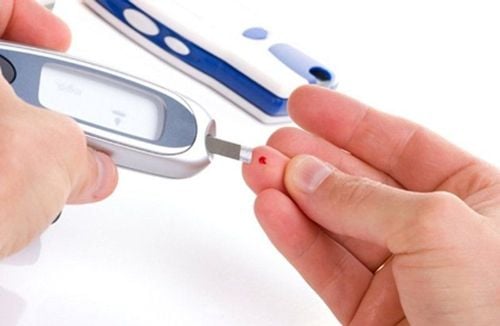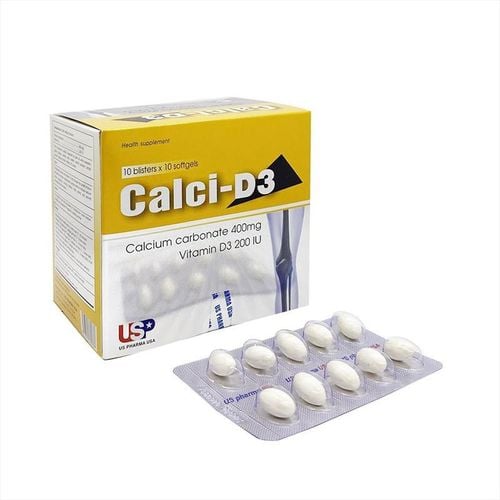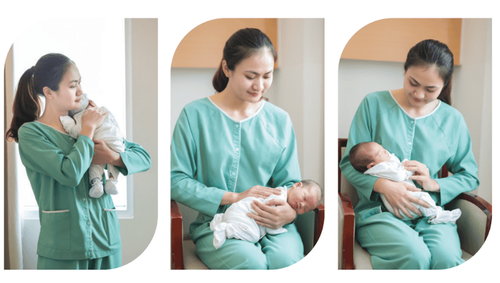This is an automatically translated article.
The article is expertly consulted by Master, Doctor Phan Thi Cam Van - Neonatologist - Department of Pediatrics - Neonatology - Vinmec Danang International General Hospital. He has 7 years of experience as a Resident Doctor and a Pediatrician - Neonatal Doctor at Hue Central Hospital and Hue University Hospital of Medicine and Pharmacy. Her strength is in the treatment of Pediatric diseases of Respiratory, Digestive, infectious diseases, newborn care and treatment, neonatal resuscitation.Sunbathing for babies to help the baby's body synthesize vitamin D and avoid rickets is always trusted by many parents. But besides that, there is still a notion that exposure to bright sunlight can also cure jaundice symptoms.
1. Vitamins EASY
Vitamin D is a form of fat-soluble vitamin, very important for the body and classified into 2 main types:
Vitamin D2 (Ergocalciferol): Derived from a few food groups rich in vitamin D (eg. such as marine fish), providing about 10% of the body's needs. Vitamin D3 (Cholecalciferol): Synthesized through the skin from the vitamin D prefix by the action of UVB rays - one of the 3 ultraviolet rays found in sunlight. Vitamin D3 provides the remaining 90% of the body's needs. The average person needs 400-1000 IU of vitamin D per day. But in fact, the amount of vitamin D obtained from food is very small and we must eat foods rich in vitamin D in large quantities to provide enough for the body. For example:
One egg yolk: There are about 20 IU of vitamin D, equivalent to eating 20 eggs to get 400 IU. Breast milk: Only from 25-79 IU/L, equivalent to drinking 10 liters of breast milk per day, can get the minimum amount of Vit D. Vitamin D-fortified formula milk: There are 350-400 IU/L, equivalent to drinking about 1 liter per day, enough vitamin D. Therefore, most of the vitamin D humans can synthesize is from the skin when in direct contact. exposure to the sun.
2. Rickets due to vitamin D deficiency
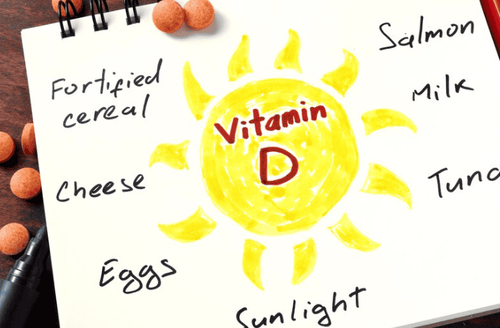
Vitamin D cần thiết cho sự phát triển của xương, chủ yếu đến từ ánh nắng mặt trời
Vitamin D plays a key role in the absorption of Calcium and Phosphorus from the intestines, helping to strengthen bones. If the body lacks vitamin D, calcium from the bones must be taken back for use, making the bones weak and deformed. This is the cause of rickets in infants as well as osteoporosis in adults. Therefore, taking calcium supplements regularly but forgetting to provide vitamin D is almost useless. In addition, Vitamin D also works to prevent certain cancers, autoimmune diseases or coronary heart disease and supports the immune system.
However, one of the major medical problems today is vitamin D deficiency, which is caused by:
Dietary vitamin D deficiency Lack of sunshine Using a lot of sunscreen According to reported data, approx. One-third of 18-29 year olds are deficient in vitamin D, and about 90% of obese or dark-skinned children have low vitamin D levels. In addition, some other subjects are also at risk of vitamin D deficiency including:
People living far from the equator (37th parallel of latitude) Dark-skinned people Obese people Older people, reduced subcutaneous fat Women are pregnant
3. Sunbathing for babies
In sunlight, there are two types of ultraviolet (UV) rays, UVA and UVB, besides there is also UVC but have been absorbed by the ozone layer.
UVA: As the culprit for wrinkling and skin aging, the cumulative effect can cause skin cancer UVB: Has a lower wavelength and is needed to make vitamin D In addition, UV rays in general also have the risk of causing skin cancer. eye diseases, which include cataracts. Therefore, in order for the sunbathing for babies to have positive effects, parents need to understand to avoid some factors that reduce the effects of UVB rays as follows:
Shade or cloudy weather ( 50% off) Dressing children in sunbathing (almost completely reduced) Air pollution Sunscreen (80-90% reduction) The darker the skin, the less effective Sun exposure through the glass window, drying Indoor sunbathing improperly puts babies at risk of skin cancer and skin aging later in life. Moreover, if the baby's sunbathing place has polluted air, the child breathes in a lot of dust, which is also a factor that causes autism. However, to sunbathe and create enough 1000 IU of vitamin D per day for your baby is almost impossible. For the above reason, the current health organizations recommend that infants should be given breast milk or formula <1 liter/day, combined with vitamin D 400 IU/day will be good for bone development. and limit the risk of skin damage caused by prolonged exposure to the sun.
4. The mistake of sun exposure to cure jaundice
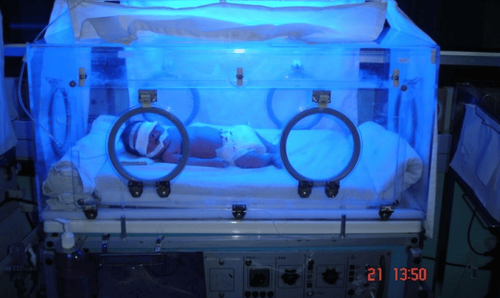
Chiếu đèn bức xạ cao điều trị vàng da ở trẻ sơ sinh
The cause of neonatal jaundice is either indirect hyperbilirubinemia or associated hepatobiliary disease. Premature babies are more prone to jaundice than full-term babies because of their slower ability to combine and excrete bilirubin. This is a physiological phenomenon and usually subsides in the first few weeks to 2 months postpartum. However, if the bilirubin is too high or the jaundice persists, it can enter the brain and cause brain damage in the newborn. Therefore, early detection of jaundice and taking the baby to the doctor for monitoring is very important. Your doctor will determine the level of bilirubin in your blood and prescribe appropriate treatment when necessary.
There are 2 main ways to treat jaundice: phototherapy and blood exchange. In particular, the light therapy method is to use 450-460 radiation waves to shine on the skin continuously for 15 minutes to start reducing bilirubin, then it takes another 4 hours to gradually achieve the optimal effect. Children have to take off all their clothes (cover only their eyes) and lie under the light continuously day and night, sometimes even using a lighted pad under their back if they have a lot of jaundice.
Therefore, normal sun exposure has no effect on the amount of bilirubin in the baby's body. On the contrary, if you stay in the sun for too long, it also exposes children to ultraviolet and infrared rays, burns the skin and increases the risk of skin cancer. Pediatric experts around the world have confirmed that bright sunlight does not make the skin yellow.
In summary, morning sun exposure only helps the infant's body synthesize vitamin D and avoid rickets, not related to the treatment of jaundice. If a child is found to have jaundice, parents need to take the child to the doctor immediately because waiting until the disease is at a late stage will risk causing very dangerous brain damage. Mild neonatal jaundice will clear up on its own in a short time, but it still requires regular monitoring by your doctor.
Pediatrics department at Vinmec International General Hospital is the address for receiving and examining diseases that infants and young children are susceptible to: physiological jaundice, viral fever, bacterial fever, ear infection middle, pneumonia in children, ... With modern equipment, sterile space, minimizing the impact as well as the risk of disease spread. Along with that is the dedication from the doctors with professional experience with pediatric patients, making the examination no longer a concern of the parents.
Especially with the safe and easy to use lighting system, babies can still breastfeed when they have to shine. There are many types of projectors suitable for each jaundiced object that needs to be illuminated: crib-shaped lights (the child lies directly on top, double lights that project above and below (used in cases where positive light is required), blanket lamps , the bag is wrapped around the young person (very convenient for the mother when taking care of the baby: you can just pick it up to breastfeed and shine the light). Severe to late, with too high bilirubin in the blood, the doctor will prescribe the use of blood exchange as a last resort. reduce bilirubin in the blood and thereby also reduce bilirubin outside the organization.
Please dial HOTLINE for more information or register for an appointment HERE. Download MyVinmec app to make appointments faster and to manage your bookings easily.
| Đăng ký tư vấn dinh dưỡng cho bé tại: https://i.vinmec.com/dangkytuvandinhduong |
|---|




